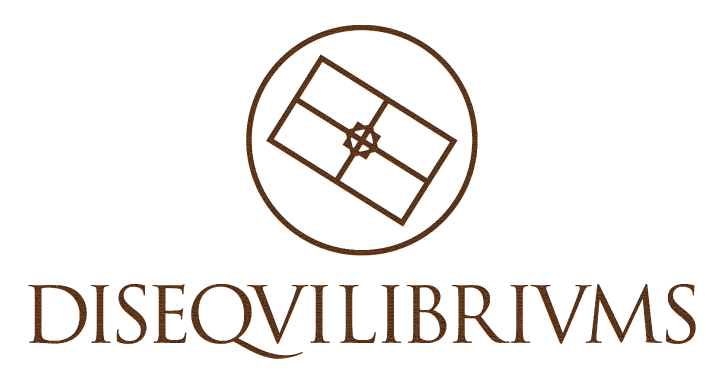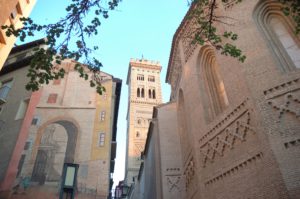DISEQUILIBRIUMS. The Individuals. Chapter 24
CHAPTER 24
Thursday 22 December 2016
Time: 4:30 pm
“Are you looking at the same thing that I am looking at?” Elsa, sitting next to me, startled me.
The two of us arrive five minutes before Sofia, and although we see her standing looking at the painting opposite, Elsa continues to converse with me to cheer me up.
“The Church of La Magdalena,” she begins to tell me, “One of the buildings which impress me most in this city. According to what we had to study for the last exam in History last year, it is in the Mudéjar style of the 14th century, although it appears to have been described as a Romanesque church in 1126. Later, the interior was renovated in the 17th and 18th centuries in the Baroque style. The original structure and the square brick tower were maintained. From what I know, I think that it is one of the prettiest church towers, especially at night when it is lit up.”
I am thankful for the distraction. All that has happened has made me very nervous.
“The truth,” I answer her, so as not to be discourteous, “is that, from all that we have seen in class last year and analysing it from the perspective of recent days, Mudéjar art has something to do with…”
“Balance!” Elsa interrupts me like a little girl who could read my thoughts and enjoy showing it off.
“Well yes. That is what I was thinking.” I look at her and smile because she’s succeeded. I continue, “In fact, it is because of co-existence in mediaeval Spain and the result of mixing Christian and Muslim artistic expressions of the period.”
I stand up. Her large eyes continue to hold me in their gaze. When she smiles, her white teeth contrast with her dark complexion and makes her face even prettier.
“You knew it well!” I continue, smiling, almost back to my normal self. “I was already aware last year that you liked that period of history.”
She shrugs her shoulders. I notice that she is blushing. I stop looking at her.
Sofia is already here. At last, she’s approaching the bench where we’re waiting for her. The two of us are sitting on the backrest of the bench with our feet on the seat.
She looks serious.
“What’s the matter, David?” It’s the first thing she asks.
“I’ll tell you after,” I answer, because I see that she is agitated, almost as if she is angry. “What’s happened to you? Something’s affected you.”
She looks at us both, then she lowers her gaze and after a little silence, she begins to speak.
As she does it, I note that she is sad, although she looks pretty.
She tells us what happened at home earlier with her mother. While she’s telling us, her body seems very light as if she’s going to fall. Her shoulders and arms seem to be weighing her down more than on other days. Her head was bent, looking down at the ground. She is angry and sad at the same time. She speaks slowly as she tells us how angry her mother became and how she was banned from entering her father’s office ever again. She continues looking down at the ground. I can’t see her expression and I can’t see her face, only a couple of tears wetting the ground.
“You are not the only one with problems.” I tell her.
I tell her what happened to my mother. She looks at me. She looks only at me as if memorising every detail of my story.
Then she comes a little closer to me and rests her head on my shoulder. I can’t believe what’s happening. I feel I am dying. If only she knew what emotions she’s arousing in me. I smell her perfume, her warmth… her body. Please, don’t let this moment end. How I love it!
Sofia looks up. As she wipes away her tears with her left sleeve, she recovers her usual decisiveness.
“After all that has happened in my house,” I stand up to continue talking, “I intend to do something. This has now spread to my family and I can’t stand by, with my arms folded.”
I don’t have to say anything more because, in the end, the same could happen to Sofia’s mother or Elsa’s parents tomorrow. But I can’t wait any longer. We have to do something.
“I am prepared to do what Nicola says,” I tell them, looking into the eyes of the two girls.
“But David,” Elsa interrupts me, “all this may be a nonsense from an old madman.” She falls silent for a moment and then looks down at the ground. “The problem is that, after all that has happened, we don’t have many more options.”
There’s silence and we all look at the church wall under which a group of children are playing with a ball while their grandmothers sit on the bench next to ours.
“By the way, where is Samuel?” I ask.
“He sent a text message saying that he is going to be late,” Elsa answers.
The three of us look at each other and as if in agreement, we shrug our shoulders at the same time.
The grandmothers next to us comment on how big their grandchildren are growing. At that moment, one of them faints. She appears to be asleep. Alarmed, we stand up to help her. The other women pay no attention to her, and continue as if nothing had happened. It’s a false alarm. Apparently, it’s normal for this lady to fall asleep in the afternoon for some minutes, her friends tell us when we show our concern.
We return to our bench.
“By the way, Sofia, you sent us a message to come here.”
She looks at us for a moment and, taking out a small notebook from her backpack, she starts writing in silence. When she finishes, she shows us a succession of numbers:
“This was written on a page in my father’s briefcase.”
After a pause, she continues talking.
“It does not tell me anything, but the main thing is why is it only today that I discover these numbers in my father’s briefcase and a photo of the little statue we saw at Nicola’s house?”
One of the children comes over to collect the ball that escaped them. Elsa catches it.
“Those are Fibonacci numbers,” says Elsa as she returns the ball to the child.
Sofia and I look at her, wide-eyed with surprise.
She doesn’t answer immediately. She wants to create a little suspense. She looks at us and smiles mischievously when she realises that, say what you will, we are going to listen to what she has to say.
“It’s very old code and it’s used for many things. The sequence starts with 0 and 1, then each number is the sum of the two numbers before.”
She falls silent and allows us to drill her with our expressions to continue talking. She smiles again and continues:
“The sequence has many special characteristics. As you proceed through the sequence of numbers on the list, you will find that the relationship between consecutive numbers is always the same: 1.6180 and more numbers after that. The Greeks called this relationship the PHI number and later, they called it the golden number or the golden section.
There’s a strong, cold gust of wind. The children stop playing. The grandmothers are all silent. The silence at this moment is unusual. There are no cars passing.
“This relationship is the fundamental pillar of sacred geometry,” Elsa finishes.
Once again, she’s just managed to get my full attention. This girl is special.
“For crying out loud! Elsa, you are a walking encyclopaedia!” It was the first thing I say.
At least, I manage to make Sofia laugh a little.
Again, in less than a week, the word geometry makes its appearance in all of this. I see surprise more all over Sofia’s face than on mine. Geometry is supposed to be her thing, but from her expression, it seems that she did not know.
“And you, how did you find out?” Sofia asks her in a tone of voice that I am unable to identify, but it isn’t one of joy.
“It’s part of history,” Elsa answers, “and it’s what I like. The PHI number comes from the Ancient Greeks. They found that, if you draw a straight line that measures PHI in two unequal parts, one of them will be one and the other is 1/PHI. It also creates other relationships.” She is silent and then looks at us again directly and says: “Do you not realise it?” She speaks with such passion that you can’t doubt anything she says. “It’s the only number which links the small one to the large one and the large one to everything. It was a true discovery.”
Elsa draws the lines and the relationships on a sheet of paper.

“I’m sorry, Elsa,” Sofia says, “but I can’t see the relationship between this and geometry.”
“The PHI number,” Elsa answers, “they call the golden number, and it is the basis for sacred geometry because it is in nature itself, and furthermore, it has been used for construction and architecture throughout history.” She makes another drawing.

There we are, the three of us, looking at the paper on which Elsa has made a drawing, while she leans back on the backrest of the bench. In the meantime, normality has now returned to the plaza with its usual sounds. The grandmothers wake up their friend and with visible effort, they get up and call the children, motioning with their arms.
“All this is because of the way they applied this relationship between the numbers 8:5 or 13:8. In other words, they constructed geometrical figures with these relationships. For example, very few people know that the size of many objects we use nowadays bear a relationship with the golden number: tobacco packs or credit cards. But the most important thing is that there are many structures in nature itself that follow the golden number, even human DNA.”
“And why did my father have this in his briefcase?” Sofia asks.
“No idea,” Elsa replies.
There we are, quietly looking closely at the drawing on the paper.
After Elsa’s answer, I didn’t know what to say and we remain a long time in silence. I cannot bear this silence. We have to do something and soon. We are stuck, but suddenly I look up at the church again and I stare at the geometrical shapes in the high windows. I break the silence:
“Do we suppose that Emperor Augustus wanted to build a sacred city? If so, it is easy to think that he would use sacred geometry.”
Seeing their faces, I feel very proud of myself. At last, it’s my comment that sheds light that neither the expert in Geometry nor the expert in History has seen.
“It’s very logical,” Sofia says.
Then, turning to look at Elsa, I say, “Elsa, on Monday you started telling us about the life of Emperor Augustus, but you didn’t finish. Could you finish telling us now?”
“Ah, yes. The most interesting thing that I was telling you is that…”
But, just at that moment, she is interrupted as Sofia stands up, looks at the church, turns around completely and stops to observe the buildings opposite the plaza. She remains pensive and watchful. With her back to the church, she starts walking towards Coso Street. She goes left and then right on the street. Then she observes the building opposite.
I admit I can’t take my eyes off her. Today, she is wearing a long purple somewhat close-fitting coat and a thick woollen cream scarf which I love. But what really mesmerises me is her long, curly wind-tossed hair. Time and time again, she would move it away from her face, revealing her neck. The coppery colour of her hair shines in the sunlight and the image of her standing there, looking at the building, distracts me from everything else. She normally carries a small brown leather backpack on her shoulder. Today, she’s carrying it on her arm as she’s constantly taking out books and notes she has been gathering in recent days. Suddenly, I feel a tap on my arm.
“Why have you never said anything to her?” I hear Elsa’s voice whispering to me.
Totally baffled and as if caught red-handed doing some childish mischief, I turn to her and ask:
“What are you talking about?”
“You know…” Elsa replies with a knowing smile. “You look miserable when you look at her. It’s not the first time. I’ve noticed it in class.”
What embarrassment! I had always thought that no one noticed it because I hid it so well. And have others also noticed it? Has Sofia? I think that I got red in the face because Elsa continues looking at me and is laughing.
“I don’t know why you are telling me,” I replied, looking at Sofia. “She’s still going out with Erik.”
There’s a little silence.
“Still…?” Elsa responds and leaves me not knowing what to say.
The truth is that with the scene we saw earlier and the fuss that Erik made, it’s unlikely that they are together. It was quite unpleasant. It would be difficult for them to be reconciled so soon. In fact, he’s not even here.
“Hey, come on over here,” Sofia shouts from where she is standing.
Both Elsa and I sit up and, circumventing the group of grandmothers and their grandchildren in the direction we are heading, we arrive at the spot where Sofia is standing. She points to the building on the other side of Coso Street and say:
“When we saw the solstice rectangle and Nicola told us the whole story, one of the things I wanted to confirm is whether the balance, that he was talking about, could have been broken because one of the reasons why the Romans built the city has not been fulfilled.”
She stops because of the noise of an ambulance passing by on the street. She waits for it to pass and continues:
“That’s why I’ve called you here and we’ve been checking it. According to the solstice rectangle, the winter solstice is certainly tomorrow at dawn. Presumably, the sun will light up the Eastern Gate, the entrance to the Church of La Magdalena. So, what’s blocking the sun?”
We are left looking at it as if it were a riddle that we have to solve immediately.
I raise my shoulders, as does Elsa.
Sofia continues, “From what I can see, it’s the buildings opposite.”
We look at each other. I think she’s hoping to surprise us, but nothing about this strikes a chord with me.
“But of course,” Sofia continues, “it would have been there a long time ago, and the disequilibrium occurring now must be linked to something recent.”
Although it seems a very logical argument, and it shows that this girl is totally caught up in the history, I don’t see anything strange or special.
I look at the building she is pointing at and it is clear that it is newer than the others around it. From one end of the block to the other, there are two shops below and an entrance door more or less in the middle of the building. It has an exterior wall painted in cream, which gives it a severe look. At first, I thought that there were three floors because of the three rows of windows, but now I see that they are very long windows corresponding to only one floor. I try to discover something else that would surprise me, but there’s nothing that stands out. I look at Sofia and shrug my shoulders. Elsa says nothing and waits for Sofia to continue.
“The building left me puzzled because it looked as if it had three floors, but if we look closer, we can see it has five. If we look at the buildings behind it, the older ones, they all have four floors. I have looked at the two sides of the building towards the end. Because the streets are fully aligned, they are lit up by the sun.”
She remains quiet for a moment and then makes a statement:
“The buildings behind, absolutely all of them have only four floors.”
She is right. I had not seen that. You have to be very observant to pick up that detail. However, I can’t see how it relates to what is happening.
“You are right,” I respond, “but I don’t see the connection with what we are doing.”
“It is because of the dawn and the time the light hits the intersection,” Elsa quickly explains.
“Exactly,” Sofia affirms.
I seem to be always behind them. It had never occurred to me. I look at the building again, the church, and it’s possible. In fact, it can affect what Nicola told us, because part of the design of balance, supposedly planned by Augustus, was based on the light and the air entering through the Decumanus and it is supposed that the effect on the intersection with the Cardus, which he called the Centre, gave rise to the fifth element which he called the Ether. So, now if the entrance of the sun on the Centre is delayed… it could be linked.
I still don’t get it.
In any case, there is something that’s not adding up for me, and leaving Coso Street behind, I turn and walk towards the church. I stop immediately at the wall of the building to the left where an original stone from the Roman wall is still preserved. I see that the girls are looking at me. Now, I am the one who is taking his time and I move to prove something.
Let’s see if Sofia is looking at me as I look at her.
I lean back against the Roman stone and turn my head to the left, in the distance, to the street that would be the Decumanus for the Romans and then in the opposite direction towards the building Sofia pointed out. Seeing me do this, the two girls come towards me. Sofia is still looking at me.
“And..?”
I already feel a little better. Again, I’ve just done something that had not occurred to her and she’s even interested in what I say. I wish the world would stop for a few minutes for me to savour the moment, with the girl I like standing very near me, looking and expecting me to discover something.
After a few fractions of a second, I can see that the world is certainly not going to stop. What a pity, how I would have enjoyed it! I answer quickly so as not to cause discomfort.
So, I start by saying, “From here, the sun should enter the Decumanus. I don’t believe that the entrance to the church marks the direction through which the sun has to enter, but rather the ancient gate, which is the street itself. What is certain is that this last stone, which is all that remains from the original wall, must be the place where the gate started for the sunlight to enter.”
From Sofia’s face, I can see that it had not occurred to her because she seriously looks at one side and then at the other, until she finally makes a gesture of agreement. So, I continue:
“As you can see, the building to the left blocks the light even though it only has four or five floors.”
I move aside for them to check it. I see that Sofia doesn’t agree. So, she moves around and looks at one side and then the other. After a while, she crosses Coso Street and walks towards the building and checks its sides, observing everything around it.
Suddenly, she stops and faces the church, towards where we are standing. She is looking at the church, with her eyes fixed on the top of the building. She puts her hand into the backpack, and both Elsa and I are amazed when she takes out small binoculars. After a while, she lowers her gaze and looks at us. I see a slight smile on her face. She crosses the street together with a group of grandparents at the lights.
When she gets back to us, she looks at me and says:
“I think you are right and the clue appears to be in the way the light enters the street, and so it does not appear that the height of the building has any effect…
She remains silent trying to imbue some mystery and then continues:
“… but I don’t know if we can explain why, in the roof of this church, someone has constructed a small arch, in the form of the ancient gate drawn on the painting we saw earlier.” And she points at the wall on the left on the other side of the street from the church.
Just at that moment, we are startled. There, standing on the other side of the street like an apparition, is Samuel with his customary long coat and the brightest trainers in the world. Hands in pockets, he watches us with an expressionless face.
Support the project and buy the book:
Other recommended books:
Writer: Glen Lapson © 2016
English translator: Rose Cartledge
Publisher: Fundacion ECUUP
Project: Disequilibriums
Register on the website www.disequilibriums.com/en/registred and you will receive a notification to allow you to read the chapters as they are published and updates of the project.





No Comments